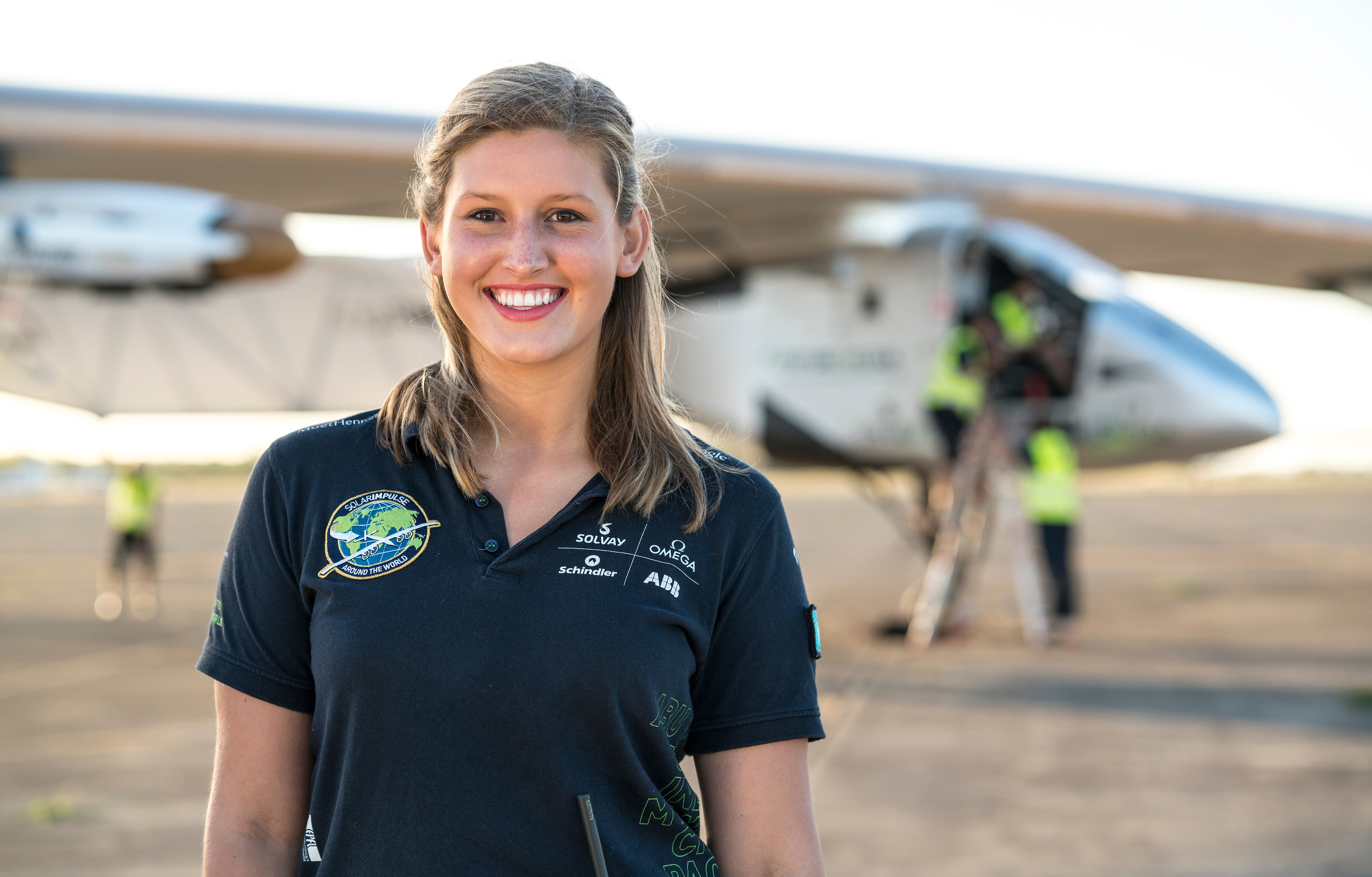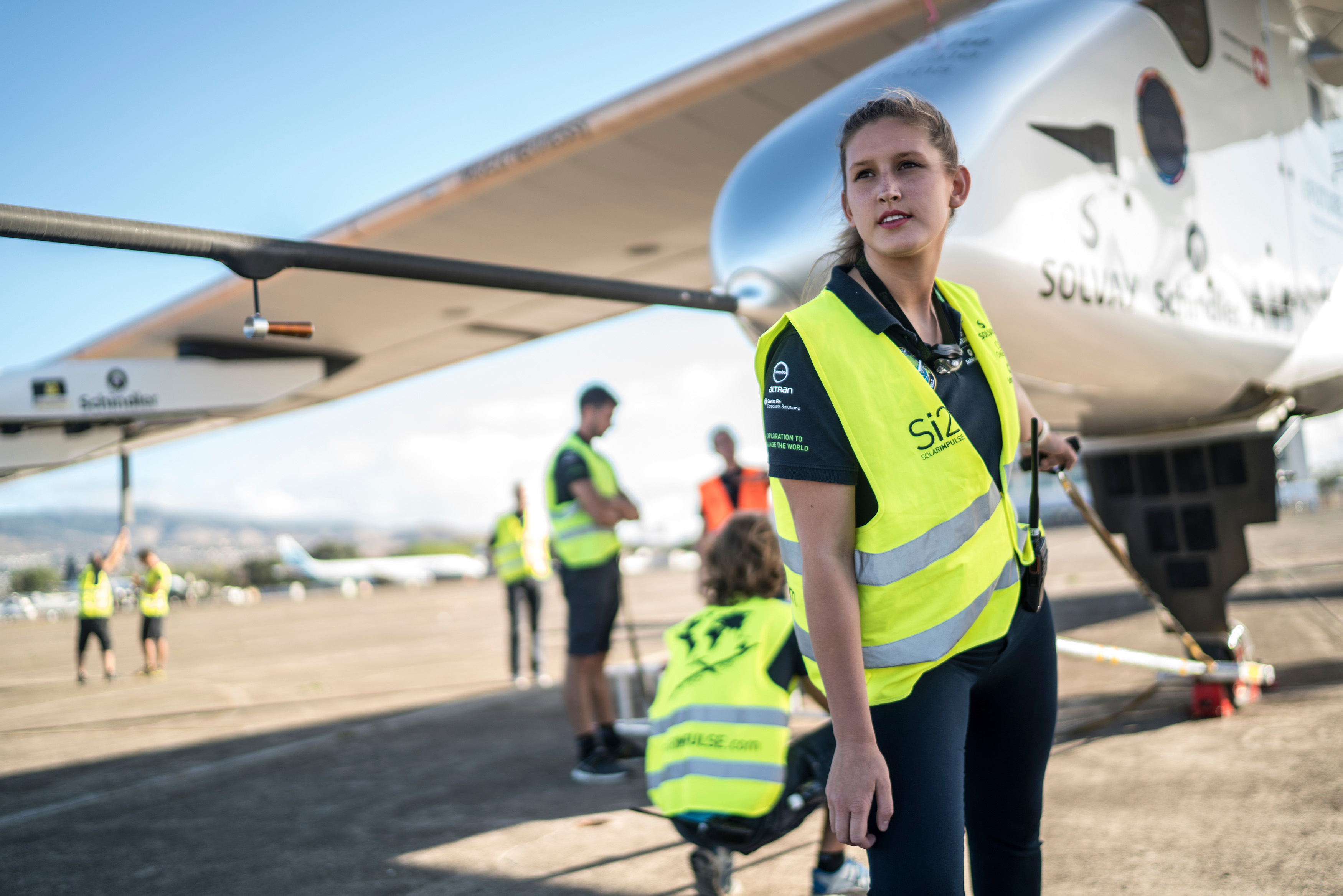Solar Impulse II crewmember pursues pilot certificate
The Solar Impulse II team depended on a 23-year-old Pittsburgh engineer as the energy-efficient, battery-powered aircraft took off or touched down at airports along its 24,854.8-mile global journey. Paige Kassalen, the crew’s first U.S. female engineer and also its youngest member, was tasked with catching and cradling the composite wingtip to keep the lengthy airfoil from scraping the ground.
She found herself either sprinting alongside the aircraft’s 236-foot-long wing as it landed or gripping it tightly against winds fighting her for lift before takeoff.
Kassalen was one of 90 people on the ground-breaking team, and she was recently named to Forbes “30 Under 30” Class of 2017 in Energy. After she learned about the flight through her job at Covestro, Kassalen jumped at the opportunity to run at 30 mph alongside the 2.3-ton aircraft and sling herself at it.

“Everyone doesn’t get to be a partner of Solar Impulse,” Kassalen said. “You had to be better than anyone else in the world to be part of the project,” she explained, referring to Covestro's energy-efficient polyurethane insulation technology, some of which has trickled down to household use.
Thinking back to her childhood, Kassalen said she charted her path to engineering when she was 7 years old and put together some furniture to help her parents. “I opened the package, threw out the directions, and assembled it myself without looking at the instructions because I wanted to understand how things clicked together and worked.”
She was a creative problem solver in elementary, middle, and high school and enjoyed STEM courses. The goal of AOPA’s You Can Fly High School Initiative is to help build and sustain aviation-based STEM programs and provide a quality workforce to the aviation industry. Kassalen said she didn’t realize until college that problem solving was the job of an engineer.
Unbeknownst to her at the time, Kassalen’s aviation experience began during a Virginia Tech high-altitude balloon experiment that involved antenna and GPS tracking systems. It was rigged with accelerometers and meteorology sensors and taught her that electrical engineers “don’t have to be in a box.” She said the cool thing about her specialty is that electrical engineering is “more than turning on light bulbs.”
One of the problems she had to help solve on Solar Impulse’s journey was how to keep the ship righted when it slowed for a landing because “there’s not a manual of how to catch the wing of a solar airplane.”
To practice, the ground crew rigged up long sections of plastic pipes with paint roller handles sticking out of them, and mounted the spindly contraption to the roof of a minivan to simulate the airplane going 30 mph and slowing down. Their goal wasn’t to slow the airplane but rather to support the wing and avoid damage by gusting winds. The landing challenge taught her that in the real world, “you’re not going to have a set of instructions” to solve problems.
Kassalen said Solar Impulse landed at about 30 mph, and the pilots would apply the airbrakes, “but it really depended on the conditions.” The ground wrangling was “never a walk, always a jog, but sometimes we’d say, ‘Oh shoot, we have to sprint.’” Kassalen said she never thought she would be “standing on the side of the runway, especially at JFK, touching the wing of an airplane.”
Just in case, the crew had electrical bicycles on standby for unexpectedly faster takeoffs or landings. “We trained so the electric bikes could zoom out onto the runway and follow the plane as it landed. It seemed like a circus act, riding a bike, holding an airplane. But every time the runners got there and the bikes were a backup, thankfully.”
She was with the project for six straight months, beginning in Hawaii about halfway through the flight when Solar Impulse returned to the skies after a lengthy mechanical delay.
“Since we flew day and night we needed to fly when the amount of time for daylight was longer than night” so its batteries could recharge more efficiently. As they waited for more favorable weather and longer days, several of her private pilot crewmembers discussed aviation and how they’d like to fly around Hawaii before the Solar Impulse journey resumed. One day they invited her to join them on a local airplane flight around the island. “I said ‘absolutely, yes!’” She savors the memory of flying over Pearl Harbor and taking in the view before a downdraft caused the aircraft to drop a bit, giving her a start. “I remember holding onto the seat so tightly, but I was surrounded by a team of pilots.”
Kassalen traveled from Hawaii to California, Arizona, Oklahoma, Ohio, Pennsylvania, New York, “and then we crossed the Atlantic to Seville, Spain; Cairo, Egypt; and Abu Dhabi in the Arab Emirates,” where the transcontinental flight ended.
“One of the biggest lessons I learned throughout the project is that without support you can really do nothing. It’s so much harder to push the boundaries of what you think, by yourself. If you have a team saying you can do it, you feel confident to go back out there and try.”
The aviation experience was worthy of future studies, so Kassalen made obtaining a pilot certificate a bucket-list item. Covestro's partnership and her enthusiasm have encouraged Kassalen's CFO to pursue his pilot certificate as well.
“Maybe I’ll set the goal for my twenty-fourth birthday to get my pilot’s license,” said Kassalen, “I feel empowered now and I can’t wait.”





